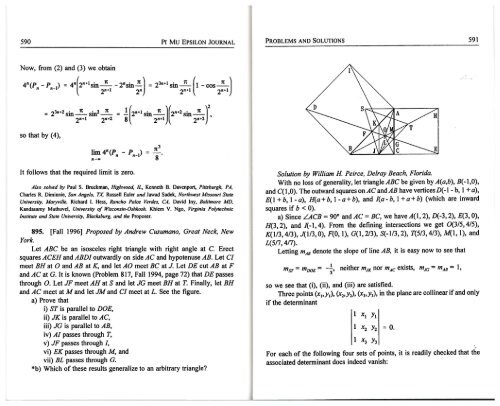Vol. 10 No 7 - Pi Mu Epsilon
Vol. 10 No 7 - Pi Mu Epsilon
Vol. 10 No 7 - Pi Mu Epsilon
You also want an ePaper? Increase the reach of your titles
YUMPU automatically turns print PDFs into web optimized ePapers that Google loves.
590 PI MU EPSILON JOURNAL<br />
PROBLEMS AND SOLUTIONS 591<br />
<strong>No</strong>w, from (2) and (3) we obtain<br />
4n(P - P ) = 4n(2n•lsin_2!_ - 2nsin~) = 2 3 n+l sin_2!_ (1 -cos~)<br />
n n-1 2 n+l 2<br />
n 2n+1 2n+1<br />
so that by ( 4),<br />
2<br />
= 23n+2 sm-- · 1t sm • 2 -- 1t -_ -1 (2n+1 sm-- · 1t )(2n+2 sm-- • 1t ) ,<br />
2n+1 2n+2 8 2n+1 2n+2<br />
lim 4n(Pn - pn-1)<br />
n-... 8<br />
It follows that the required limit is zero.<br />
Also solved by Paul S. Bruckman, Highwood, IL, Kenneth B. Davenport, <strong>Pi</strong>ttsburgh, PA,<br />
Charles R. Diminnie, San Angelo, TX. Russell Euler and Jawad Sadek, <strong>No</strong>rthwest Missouri State<br />
University, Maryville, Richard I. Hess, Rancho Palos Verdes, CA, David Iny, Baltimore MD,<br />
Kandasamy <strong>Mu</strong>thuvel, University of Wisconsin-Oshkosh, Khiem V. Ngo, Virginia Polytechnic<br />
Institute and State University, Blacksburg, and the Proposer.<br />
895. [Fall 1996] Proposed by Andrew Cusumano, Great Neck, New<br />
York.<br />
Let ABC be an isosceles right triangle with right angle at C. Erect<br />
squares ACEH and ABDI outwardly on side AC and hypotenuse AB. Let C/<br />
meet BH at 0 and AB at K, and let AO meet BC at J. Let DE cut AB at F<br />
and AC at G. It is known (Problem 817, Fall 1994, page 72) that DE passes<br />
through 0. Let JF meet AH at Sand let JG meet BHatT. Finally, let BH<br />
and AC meet at M and let JM and C/ meet at L. See the figure.<br />
a) Prove that<br />
i) ST is parallel to DOE,<br />
ii) JK is parallel to AC,<br />
iii) JG is parallel to AB,<br />
iv) AI passes through T,<br />
v) JF passes through/,<br />
vi) EK passes through M, and<br />
vii) BL passes through G.<br />
*b) Which of these results generalize to an arbitrary triangle<br />
Solution by William H Peirce, Delray Beach, Florida.<br />
With no loss of generality, let triangle ABC be given by A(a,b), B(-1,0),<br />
and C(1,0). The outward squares on AC andAB have verticesD(-1- b, 1 +a),<br />
E(1 +b, 1-a), H(a+b, 1-a+b), and l(a-b, 1 +a+b) (which are inward<br />
squares if b < 0).<br />
a) Since LACB = 90° and AC = BC, we have A(1, 2), D(-3, 2), E(3, 0),<br />
H(3, 2), and /(-1, 4). From the defining intersections we get 0(3/5, 4/5),<br />
K(I/3, 4/3), J(l/3, 0), F(O, 1), G(1, 2/3), S(-1/3, 2), T(5/3, 4/3), M(1, 1), and<br />
L(517, 417).<br />
Letting m AB denote the slope of line AB, it is easy now to see that<br />
1<br />
"h "t m -1<br />
msr = m 00<br />
E = --, nett er m;K nor mAc exts s, m;a = AB- ,<br />
3<br />
so we see that (i), (ii), and (iii) are satisfied.<br />
Three points (x 1<br />
,y 1<br />
), (x 2<br />
,y 2<br />
), (x 3<br />
,y 3<br />
), in the plane are collinear if and only<br />
if the determinant<br />
1 XI Yt<br />
1 x 2<br />
y 2 = 0.<br />
1 x3 y3<br />
For each of the following four sets of points, it is readily checked that the<br />
associated determinant does indeed vanish:
















